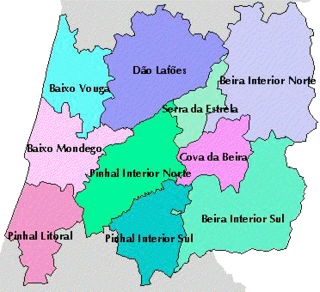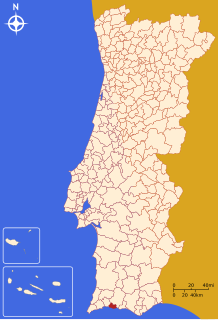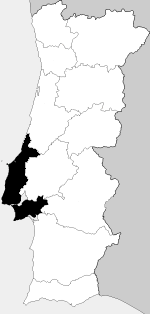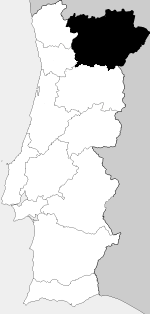
Vinho Verde refers to Portuguese wine that originated in the historic Minho province in the far north of the country. The modern-day 'Vinho Verde' region, originally designated in 1908, includes the old Minho province plus adjacent areas to the south. In 1976, the old province was dissolved.

Douro is a Portuguese wine region centered on the Douro River in the Trás-os-Montes e Alto Douro region. It is sometimes referred to as the Alto Douro, as it is located some distance upstream from Porto, sheltered by mountain ranges from coastal influence. The region has Portugal's highest wine classification as a Denominação de Origem Controlada (DOC). While the region is associated primarily with Port wine production, the Douro produces just as much table wine as it does fortified wine. The non-fortified wines are typically referred to as "Douro wines".

Dão is a Portuguese wine region situated in the Região Demarcada do Dão with the Dão-Lafões sub region of the Centro, Portugal. It is one of the oldest established wine regions in Portugal. Dão wine is produced in a mountainous region with a temperate climate, in the area of the Rio Mondego and Dão rivers in the north central region of Portugal. The region became a Denominação de Origem Controlada (DOC) appellation in 1990. The Dão region is the origin of the Touriga Nacional vine that is the principal component of Port wine.
Bairrada is a Portuguese wine region located in the Beira Litoral Province. The region has Portugal's highest wine classification as a Denominação de Origem Controlada (DOC). It is located close to the Atlantic which ocean currents have a moderating effect on the climate. The region is bordered to the north by the Lafões IPR and to the east by the Dão DOC. The region is known for its deep colored tannic red wines that often have bell pepper and black currant flavors as well its emerging rosé production. The boundaries of the Bairrada DOC includes the municipalities of Anadia, Cantanhede, Mealhada and Oliveira do Bairro.

Lagoa is a town in the former-district of Faro, in the Portuguese region of the Algarve. The population in 2011 was 22,975, in an area of 88.25 km². Its urban population is 6100 inhabitants.

Alentejo is a Portuguese wine region in the Alentejo region. The entire region is entitled to use the Vinho Regional designation Alentejano VR, while some areas are also classified at the higher Denominação de Origem Controlada (DOC) level under the designation Alentejo DOC. VR is similar to the French vin de pays and DOC to the French AOC. In the southern half of Portugal, the Alentejo region covers about a third of the country and is sparsely populated. In 2005, South Oregon University scientist Gregory V. Jones identified Alentejo as the world's most challenged wine region from a climate change perspective. The region is noted for it vast cork production but has in recent years garnered attention for its table wine production. Some producers of this region still do wine in great potteries as in Roman times.
The denominação de origem controlada is the system of protected designation of origin for wines, cheeses, butters, and other agricultural products from Portugal.
Lagoa is a Portuguese wine region centered on the Lagoa municipality in the Algarve region. The region has Portugal's highest wine classification as a Denominação de Origem Controlada (DOC). The region is bordered to the west by the Portimão DOC and to the east by Tavira DOC. The region has been historically known for its fortified wine production but has been expanding its table wine production in recent years.
Lagos is a Portuguese wine region centered on the Lagos municipality in the Algarve region. The region has Portugal's highest wine classification as a Denominação de Origem Controlada (DOC). Located on the southwestern corner of Algarve, the region is bordered to the east by the Portimão DOC.
Tavira is a Portuguese wine region centered on the Tavira Municipality in the Algarve region. The region has Portugal's highest wine classification as a Denominação de Origem Controlada (DOC). Extending to the Spanish border, the region is flanked on the west by the Lagoa DOC.

Algarve is a Portuguese wine region covering the same areas as its namesake region. The region is classified as a Vinho Regional (VR), a designation similar to a French vin de pays region. Located on the southern coast of Portugal, the region's wine industry is driven by the local tourist economy with very few wines being exported.

Beiras is a Portuguese wine region covering the same areas as its namesake region. The region is classified as a Vinho Regional (VR), a designation similar to a French vin de pays region. Located in the northern regions of Portugal, Beiras produces wines of every imaginable style including sparkling and fortified wines but quality varies dramatically depending on producer and region.

Lisboa, until 2009 named Estremadura, is a Portuguese wine region covering the same areas as the Estremadura region, and taking its name from the country's capital. The region is classified as a Vinho Regional (VR), a designation similar to a French vin de pays region. While the Beiras and Alentejo VRs are largest geographically, the Lisboa region is Portugal's largest producer of wine by volume. The region stretches from Lisbon along the Atlantic coast to the Bairrada DOC.

Tejo, until 2009 named Ribatejo, is a Portuguese wine region covering the same areas as the Ribatejo Province. It takes its name from the river Tejo (Tagus). The entire region is entitled to use the Vinho Regional designation Tejo VR, while some areas are also classified at the higher Denominação de Origem Controlada (DOC) level under the designation DoTejo DOC. VR is similar to the French vin de pays and DOC to the French AOC.

Trás-os-Montes is a Portuguese wine region located in the Trás-os-Montes e Alto Douro region. The entire wine region is entitled to use the Vinho Regional designation Transmontano VR, while some areas are also classified at the higher Denominação de Origem Controlada (DOC) level under the designation Trás-os-Montes DOC. VR is similar to the French vin de pays and DOC to the French AOC.












